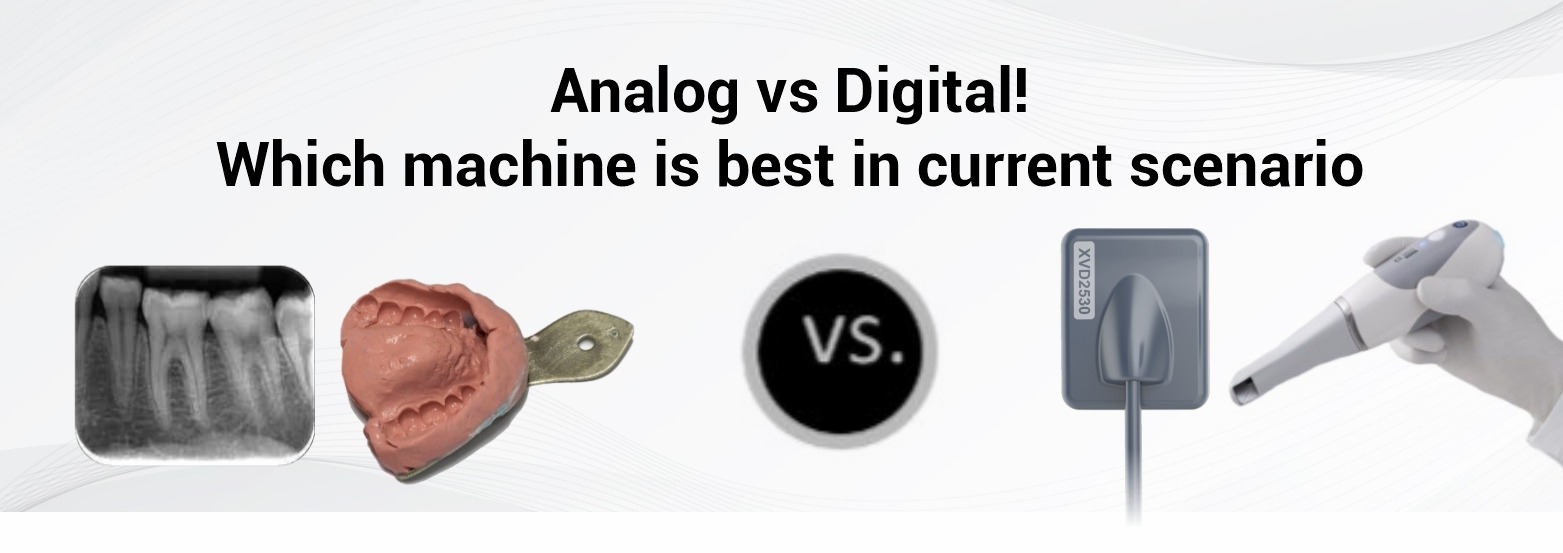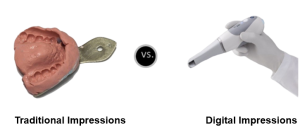Analog Vs Digital – Which Machine Is Best In Current Scenario??
Analog and Digital dentistry are two different approaches to providing dental care.
Analog Dentistry:
Analog dentistry refers to the traditional methods of performing dental procedures, which rely on manual tools and techniques.
This includes procedures such as taking impressions, creating dental models, and shaping teeth with manual tools such as drills, burs, and other instruments.
Digital Dentistry:
On the other hand, Digital Dentistry involves the use of advanced technology to improve the accuracy, efficiency, and precision of dental procedures.
This includes the use of computer-aided design (CAD) and computer-aided manufacturing (CAM) technologies, digital x-rays, and 3D printing in the procedures such as digital impressions, computer-aided design of dental restorations, and the use of digital tools such as lasers and intraoral cameras.
FEATURES:
Here are some of the key differences between analog and digital dentistry:
- Accuracy: Digital dentistry is often more accurate than analog dentistry. For example, intraoral scanners can capture precise measurements of a patient’s teeth, which can then be used to create a 3D model of the patient’s mouth. This can help dentists create more accurate dental restorations, such as crowns and bridges.
- Efficiency: Digital dentistry can often be more efficient than analog dentistry. For example, digital impressions can be captured much more quickly than traditional impressions, which can save time for both the dentist and the patient.
- Patient experience: Digital dentistry can improve the patient experience in several ways. For example, intraoral scanners are less invasive than traditional impressions, which can help patients feel more comfortable during the dental appointment.
- Cost: Digital dentistry can be more expensive than analog dentistry, as it often requires more expensive equipment and training.
However, digital dentistry can also reduce costs in other areas, such as reducing the need for physical impressions and decreasing the need for multiple appointments.
Advantages of Analog Dentistry:
Dentists who are experienced in analog dentistry have a tactile and visual sense of the work they are doing and can feel the resistance of the tooth or gum tissue when performing procedures.
Patients may feel more comfortable with the traditional approach, as they can see the work being done and may feel more involved in the process.
Advantages of Digital Dentistry:
Digital dentistry can be faster and more precise than analog dentistry, resulting in less time spent in the dentist’s chair and fewer appointments needed for a single treatment.
The use of digital tools can reduce discomfort and pain during procedures, as well as the need for local anesthetic in some cases.
The accuracy and precision of digital dentistry are typically higher, as it relies on computerized systems rather than the dentist’s manual dexterity.
For example, CAD/CAM technology can be used to create customized dental restorations, such as crowns and bridges, in a single visit to the dentist, rather than requiring multiple appointments.
Digital dentistry also allows for more efficient communication between dental professionals and with patients, as digital records can be easily shared and accessed.
Disadvantages of Analog Dentistry:
Analog dentistry can be time-consuming and may require multiple appointments for a single treatment.
The accuracy and precision of analog dentistry may be limited, as it relies on the dentist’s manual dexterity.
Disadvantages of Digital Dentistry:
Digital dentistry requires specialized equipment and software, which can be expensive and may not be available in all dental offices.
Some patients may feel less comfortable with the use of technology in dental procedures and may prefer a more traditional approach.
ANALOG VS DIGITAL IMAGE QUALITY
The quality of analog and Digital Images can vary depending on the equipment and techniques used. However, in general, digital images have the potential to offer higher quality and more consistent results than analog images.
Analog images, such as traditional x-rays, are produced by exposing a photographic film to radiation. This process can result in images that are less detailed and less consistent than digital images. The quality of analog images can also be affected by factors such as film processing and storage conditions.
In contrast, digital images are produced using digital sensors that capture the image and convert it into digital data. This process can result in images that are more detailed, sharper, and more consistent than analog images.
Digital images can also be manipulated and enhanced using software, which can improve their overall quality.
Furthermore, digital images can be viewed and shared more easily than analog images. They can be stored in electronic health records and can be easily accessed and shared with other healthcare providers, which can improve patient care and collaboration among healthcare professionals.

PERSONAL OPINION
The choice between analog and digital machines depends on various factors, such as the specific needs of the patient, the dentist’s expertise, and the available equipment.
However, in many cases, Digital machines are considered superior to analog machines in terms of accuracy, precision, and efficiency.
For example, digital X-rays are faster, produce less radiation exposure, and provide better image quality than traditional film X-rays. Similarly, digital intraoral scanners provide more accurate and detailed impressions of teeth and oral structures, which can result in better fitting restorations such as crowns, bridges, and implants.
However, there are some instances where Analog machines may be more appropriate, such as when a dentist needs to make minor adjustments to a restoration that cannot be done with digital tools.
Analog machines are tried and tested, and many dentists have years of experience using them. They offer tactile feedback, which can be helpful in certain procedures, and they may be more accessible and affordable for some dental practices.
CONCLUSION
Overall, both analog and digital machines have their own advantages and limitations, and the best choice depends on a variety of factors, including the specific needs and preferences of the patient, the expertise of the dental professional, and the available resources and technology. Dentists may choose to use a combination of analog and digital tools to provide the best possible care for their patients.
It is important for dental professionals to stay up-to-date with the latest technology and equipment to provide the best possible care for their patients.






Leave a comment